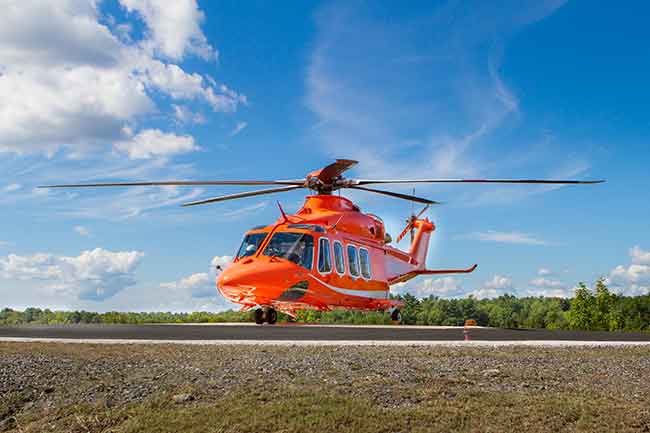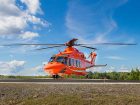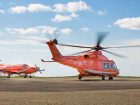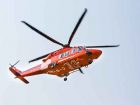
Features
Commercial
Operator Profiles
An ORNGE Revival
March 15, 2016 By Matt Nicholls
Focus, integrity, clarity, leadership. They’re critical attributes in establishing success at any operation and they’re even more necessary when an organization has gone through periods of scrutiny and corporate strife.
 The AW139 remains the helicopter of choice for ORNGE. Focus
The AW139 remains the helicopter of choice for ORNGE. FocusFor Ontario’s medical transport provider ORNGE, the past four years have seen plenty of difficult times and in many ways, public scrutiny remains. The OPP, for example, is continuing its investigation into the alleged financial irregularities by the former ORNGE corporate regime led by then president/CEO Christopher Mazza.
ORNGE is also continuing to refine its safety procedures following the crash of a S-76A Sikorsky helicopter on May 31, 2013 in Moosonee, Ont., killing Captain Don Filliter, first officer Jacques Dupris and flight paramedics Dustin Dagenais and Chris Snowball. The organization was slapped with 17 allegedly questionable charges from federal investigators for its questionable safety procedures in the accident.
Trying times indeed but as a new year beckons, the rebuilt ORNGE leadership team is soldiering on, working diligently to enhance safety and operational procedures, regain pubic trust and, most importantly, provide timely, efficient care to patients in need while working more prudently with the facilities that care for them.
“It has been a multi-prong attack to work to put this back together,” Andrew McCallum, president/CEO of ORNGE told Helicopters. “The first thing we did was get a team in place that could actually manage the company properly.”
McCallum joined ORNGE in January 2013, bringing a fresh, energetic and positive attitude that has been a breath of fresh air to both ORNGE employees and clients alike. He boasts an extensive medical and aviation background, having served as both a flight surgeon and medical officer in the Royal Canadian Air Force (RCAF).
The leadership team also includes COO Rob Giguere, who was hired just prior to McCallum’s appointment. Giguere is a distinguished aviation professional with more than four decades in the industry. He previously held senior executive positions with Skyservice Airlines and Air Canada.
Homer Tien, chief medical officer, joined ORNGE last year. Tien came over from Toronto’s Sunnybrook Health Sciences Centre and has had a decorated career in Canadian medical circles. A former colonel in the RCAF, Tien was also a staff general surgeon and medical officer in Afghanistan, Bosnia and Herzegovina, Croatia and Myanmar.
“I give my predecessor credit for hiring Rob,” McCallum says. “He is a consummate aviation professional who knows aviation in and out and he’s brought a different type of leadership style to the aviation side. And of course getting Homer to join us last summer was a major step in reinventing the medical side of the organization. Homer is a top medical surgeon with extensive knowledge of the military environment, so he has lots of experience with medical evacuation within a combat setting. He understands this side of it, the logistics side of things.”
Re-tooling the leadership team and improving key elements in base organization and operational control was only part of the revival process. Shortly after taking the helm, McCallum worked closely with internal staff, the government and ORNGE stakeholders to redefine and solidify the organization’s purpose: develop an ironclad strategic plan that met the needs of patients and industry partners.
“Let’s just say the direction was not clear [when I came on board]. ORNGE was built to do something else than it does now,” McCallum says. “Our focus is integrating patient care in Ontario . . . that is what we do. We extend the reach of health care. That’s our vision. And the way we do that, is transporting patients safely to the places that they need. Those are all articulated in our vision mission and values, but they are different than what existed at the time.”
The difference in corporate vision and philosophy, McCallum notes, was not exactly clear. One of the key problems was the organization was trying to establish a medical transport service model that could be transferred and implemented in municipalities around the world – taking its focus away from the direction it needed to follow in Ontario. Patients and other medical facilities ORNGE serves were neglected and being placed in serious jeopardy.
“The planning process was so important for us,” McCallum notes. “For one, it codified the goals and objectives we had. It was also an inclusive process – we brought in several of our partners to discuss things with. And that did two things. It informed the process, and two, it’s fair to say ORNGE had not been very connected to the people it works for. The biggest criticism I had been hearing was ‘you aren’t listening to us.’ This process went some way into re-establishing that connection.”
An improved direction and commitment to getting back to basics – improving patient outcomes, safety, paramedic services, response times, system integration and more – has helped ORNGE win back the respect it had lost with many of its closest stakeholders and clients. Patient response times have drastically improved, there is better communication and cohesion between bases, and aviation safety and coordination with ground ambulance options has greatly increased. Deploying the correct medical asset – be it helicopter or ambulance – is also coordinated and evaluated more efficiently.
“There’s no question, things have been steadily improving,” McCallum notes. “When you talk to our some of our stakeholders . . . they were requesting the formation of a working group to deal with the issues at ORNGE. And it actually didn’t get off the ground because they said we don’t need it anymore. We are now part of the system – an important component as an adjunct to what they do, particularly in the north.”
Improvements in the Skies
Corporate and operational changes are not the only areas of improvement at ORNGE. As Giguere notes, much has transpired on the aviation side to help establish a new commitment to safety and excellence.
“We continue to enhance our operations,” he says. “We have new processes to mentor some of the younger folks. And on the training side, we will be the first operator in Canada to have a PC-12 Level D authorization for SIM training. We are working with FlightSafety International on that. We are also doing both the Finnemaccia AW139 and Sikorsky S-76 SIM training with FlightSafety. These are great tools, great devices and the outcomes have been really strong.”
In the past few months, ORNGE has also been working with NVGs to improve flying at night. ORNGE is training 11 pilots at its Sudbury base with NVGs and has retrofitted one of its AW139s for the trial. The NVGs may help prevent nighttime incidents and help improve situational awareness. ORNGE currently relies on solar lighting to help pilots land at some of its bases and the NVGs will be an essential tool in offering safer operating procedures.
“We did an RFP process to get the aircraft certified to get an STC on it and we equipped some of our training pilots at the Sudbury base for the trial, mostly because it is in an area where it can be particularly useful, but [also] because of the high frequency of calls,” Giguere says. “It is still very early in the trial, but the feedback has been overwhelmingly positive. The NVGs will really assist at those pads that suffer from black hole illusion where there is no cultural lighting. For en route and night VFR, NVGs are particularly useful for obstacle clearance and options en route.” ORNGE does not intend to change its operating profile, just add a safety enhancement for more capability at night.
ORNGE has also added more solar lights at helipads throughout the province and is changing aspects of its operating procedures, such as implementing proficiency flying exercises. With the proficiency flying exercises, ORNGE pilots can take aircraft out in non-revenue situations to practise certain exercises such as IFR flying; flying to pads that have black hole illusion; perform hover exits; and general night flying VFR.
“Now we allow our crews – and it’s something that has never been authorized before – to give them the ability to practise in these scenarios,” Giguere says. “The incremental cost is just fuel – it’s not a major cost for us to do. These aircraft are not out of service – in fact they can respond faster to calls if we get them because they are in the air.”
ORNGE has also started to build VFR approach plates for the helipads it goes to throughout Ontario. Giguere says it has 20 built now and the plan is to continue development. “It is just another aid and tool for the pilots to use,” he says. “When the pilots are looking for a pad, you can program it in, and this will give them a more accurate profile into the pad. Combined with the NVGs, this will be significant.”
Making the Right Choice
Another critical process ORNGE concluded recently was a reassessment of its helicopter fleet to determine if the AW139 was indeed the right platform for the job. The previous regime had purchased the existing 10-helicopter fleet from AgustaWestland (now Finmeccanica Helicopters) but the new team wanted to ensure the organization had the right aircraft in place.
“Part of our decision to re-evaluate the fleet was to see if we can justify the decisions made by the previous management,” Giguere says. “There was some noise around the AW139 as to whether it was the right way to go. Plus, there are market changes and new aircraft. We went out to an RFI, which was part of our mandate from that strategic session [in 2013], to determine if there was another platform that could do as good a job at an equal or lessor cost without any change in capital. The conclusion is no, there isn’t. That is not to say there are not great helicopters out there that can do the same job. There are just different sets of circumstances.”
The final decision was also influenced by the fact that ORNGE crews are familiar with the platform already, are trained on it, and it is doing a sufficient job. Changes are in the works for the problematic helicopter interior. The initial design has long been scorned by paramedics for its inefficient configuration – some procedures could not be done well or at all. A new interior has been designed and is currently being evaluated by ORNGE medical teams and engineers.
Keeping Things Moving Forward
Retooling an organization after significant negativity is never an easy thing and it certainly isn’t an instant fix. McCallum however is quite pleased with the progress his organization has made, and continues to make every day. In the course of our interview, he shared many examples of how the public – and frontline ORNGE employees – continuously express their pride for being part of such an important organization, one imperative for the health and safety of so many people, particularly in the north where ORNGE is really the “only game in town” when it comes to medical care. He is also not complacent about the challenges that lie ahead for the organization in spite of the progress it has made.
“We have a lot of challenges for sure,” he says. “We are a government organization and you know they are tight for funds, and aviation costs are going up. We are working within these realities. We have a very good working relationship with the government, they see their oversight role as a very important one. Four years ago, it was not good. And it has taken quite a while to rebuild that trust. Now, we have a relationship where, if things go wrong, we communicate. We don’t want them ever to be surprised. And when we have issues, we deal with them.”
Giguere concurs and adds that “the entire organization is proud of what they do and it shows from our front-line people at our community events. We are proud of the accomplishments they make.”
As for Tien, who is rapidly improving ORNGE’s medical reach with technological enhancements and improvements in several key areas, he sums things up with surgical precision. “It is hard to imagine what the organization was like four years ago,” he says. “[There is] definitely a bit of a disconnect with what you read in the newspapers. We are definitely making progress.”
A succinct, essential message from an organization that is highly necessary, needed and valued throughout the province.



